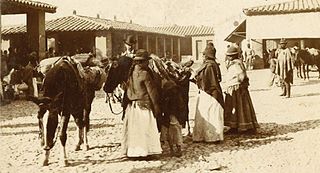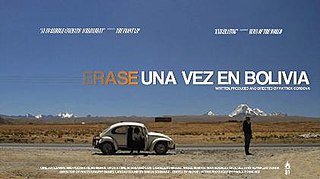
The politics of Bolivia takes place in a tree of a presidential representative democratic republic, whereby the president is head of state, head of government and head of a diverse multi-party system. Executive power is exercised by the government. Legislative power is vested in both the government and the two chambers of parliament. Both the Judiciary and the electoral branch are independent of the executive and the legislature. After the 2015 election, 53.3% of the seats in national parliament were held by women, a higher proportion of women than that of the population.

The Aymara or Aimara people are an indigenous people in the Andes and Altiplano regions of South America; about 2.3 million live in northwest Argentina, Bolivia, Chile, and Peru. Their ancestors lived in the region for many centuries before becoming a subject people of the Inca in the late 15th or early 16th century, and later of the Spanish in the 16th century. With the Spanish American wars of independence (1810–1825), the Aymaras became subjects of the new nations of Bolivia and Peru. After the War of the Pacific (1879–1883), Chile annexed territory with Aymara population.

Andean music is a group of styles of music from the Andes region in South America.

Neo-futurism is a late-20th to early-21st-century movement in the arts, design, and architecture.

El Alto is the second-largest city in Bolivia, located adjacent to La Paz in Pedro Domingo Murillo Province on the Altiplano highlands. El Alto is today one of Bolivia's fastest-growing urban centers, with an estimated population of 943,558 in 2020. It is also the highest major city in the world, with an average elevation of 4,000 m (13,123 ft).
The first Bolivian judicial election was held on 16 October 2011. The national vote was held to elect magistrates to serve on the Supreme Court of Justice, the Plurinational Constitutional Court, the Agro-environmental Court and members of the Judiciary Council. It was originally scheduled to be held on 5 December 2010, but officials of the National Electoral Court and of the MAS majority in the Plurinational Legislative Assembly delayed it. The vote will be the first time that a Latin American country directly elects its highest judicial officials.

The National Council of Ayllus and Markas of Qullasuyu is a confederation of traditional governing bodies of Quechua-, Aymara- and Uru-speaking highland indigenous communities in the departments of La Paz, Oruro, Potosí, Cochabamba, Chuquisaca and Tarija, Bolivia. Specifically, it represents the following 16 suyus: Jacha Carangas, Jatun Quillacas, Asamajaquis, Charcas Qara Qara, Council of Ayllus of Potosí, Qara Qara Suyu, Sora, Kallawaya, Leco, Larecaja, Colla, Chui, Paca Jake, Ayllus of Cochabamba, Kapaj Omasuyus and Yapacaní. CONAMAQ was founded on March 22, 1997, with the purpose of restoring the self-governance of "original nations" including "collective rights to land and natural resources, re-definition of administrative units and self-determination exercised through indigenous autonomies and direct representation in state institutions." CONAMAQ is a member of the National Coordination for Change, and of the Andean Coordination of Indigenous Organizations. It was a member of the Pact of Unity in Bolivia from its founding until December 2011.

Once Upon a Time in Bolivia is a 2012 independent Bolivian road movie that was written, produced and directed by Patrick L Cordova. The film stars Luis Caballero and Miguel Angel Mamani as two half-brothers of mixed race who find themselves in a sprint to the Bolivia-Chile border.
Fran Silvestre Arquitectos is a studio based in Valencia made up a multidisciplinary group of architects founded in 2005 by architect Fran Silvestre.

ArchDaily is a weblog covering architectural news, projects, products, events, interviews and competitions, opinion pieces, among others, catering to architects, designers and other interested parties.

The architecture of Bolivia is closely related to its history, culture and religion. Bolivian architecture has been constantly changing and progressing over time. Subject to terrain and high altitudes, most of Bolivia's Pre-Columbian buildings were built for housing, mainly influenced by Bolivian indigenous culture. The arrival of Spanish settlers brought many European-style buildings, and the Spaniards began planning to build big cities. After Independence, the architectural style became Neoclassical and many churches and government buildings were built. In modern Bolivia, like many countries, skyscrapers and post-modern buildings dominate, and of course there are special styles of architecture to attract tourists and build.
Beirut Terraces is a residential skyscraper in the Central district of downtown Beirut, Lebanon. It is located at 1399 Fouad Najjar Street in the Minet el-Hosn neighborhood, south of the Platinum Tower. It has 26 floors with an overall height of 119.5 m (392 ft). The building construction started in 2011 and finished in 2017. It was developed by Benchmark and designed by Herzog & de Meuron Architekten.

Antonia Wilma Alanoca Mamani is a Bolivian journalist, politician, and television presenter who served as minister of cultures and tourism from 2017 to 2019. A member of the Movement for Socialism, she previously served an El Alto municipal councilor from 2015 to 2017, a position she returned to in 2021.

Neo-Andean is a contemporary architectural movement primarily situated in El Alto, Bolivia, expressed in the city's many cholets, or mini-mansions, and dancehalls. Bolivian architect Freddy Mamani has been described as "the best-known architect" of neo-Andean architecture. Mamani is "a civil engineer who began as a simple laborer two decades ago" and has built over 60 neo-Andean structures in El Alto since 2005.
Events in the year 2021 in Bolivia.

The Bank of Spain building is an eclectic early-20th-century building in the Spanish city of Pontevedra.

Isabella Brunilda Mamani Mamani is an Aymara attorney and politician in Chile. In 2021, she was elected to represent the Aymara people in a reserved seat on the Chilean Constitutional Convention.

The Charaña Accord, also known as the Hug of Charaña or the Act of Charaña, is the name given to an unrealized treaty that was discussed between the dictators of Bolivia and Chile, Hugo Banzer and Augusto Pinochet respectively. These discussions took place mostly on the Bolivian train station of Charaña on February 8, 1975, and included the brief reestablishment of diplomatic relations between the two nations which had been severed on 1962 because of the Atacama border dispute which was to be solved via a Chilean proposal for the exchange of territories between Bolivia and Chile, with the former receiving a corridor to the Pacific Ocean which would provide it with access to the sea and Chile receiving an equivalent amount of territory from Bolivia along its border with Chile.
The 2019 Senkata massacre occurred when Bolivian soldiers and police broke up a road blockade at the YPFB gas facility in Senkata, El Alto, Bolivia, on 19 November 2019. It occurred one week into the interim presidency of Jeanine Áñez and four days after the Sacaba massacre. Rural and urban protesters had blockaded the plant shortly after the ouster of Bolivian president Evo Morales. Their protests were part of nationwide blockades by his supporters denouncing the ouster as a coup d'état, and urban protests in El Alto against the new government's desecration of the wiphala, an Indigenous flag designated a Bolivian national symbol by the 2009 Constitution. By 14 November, protesters had built barricades as part of their blockade.

Freddy Mamani Laura is a Bolivian educator, politician, and trade unionist who served as president of the Chamber of Deputies from 2020 to 2022. A member of the Movement for Socialism, he has served as a party-list member of the Chamber of Deputies from La Paz since 2020. He previously served as executive secretary of the National Confederation of Rural Teachers of Bolivia and as departmental executive of the Federation of Rural Teachers of La Paz. Prior to entering politics, Mamani worked as a teacher, serving as the principal of various rural schools in the department.
















